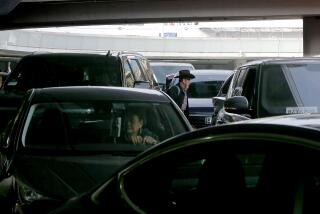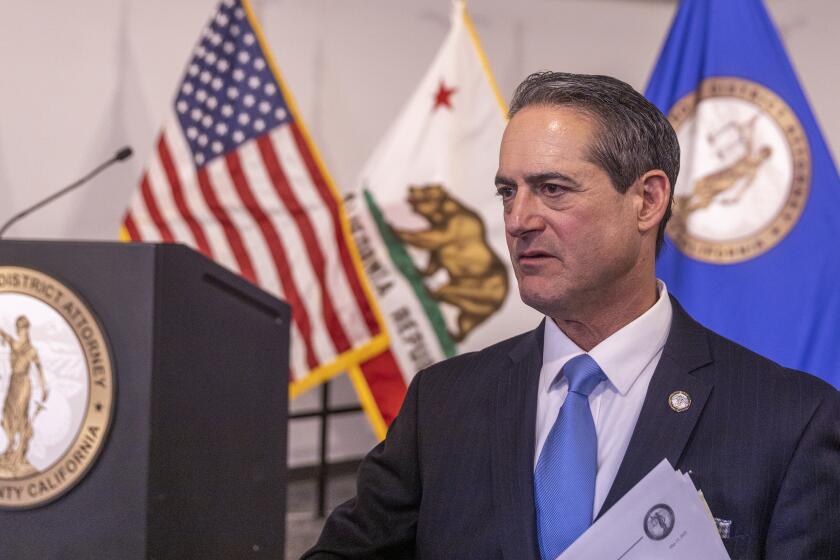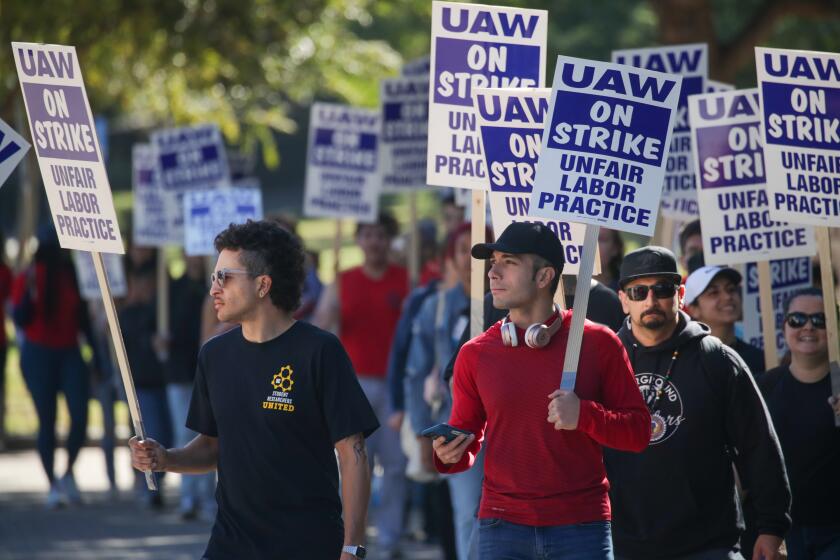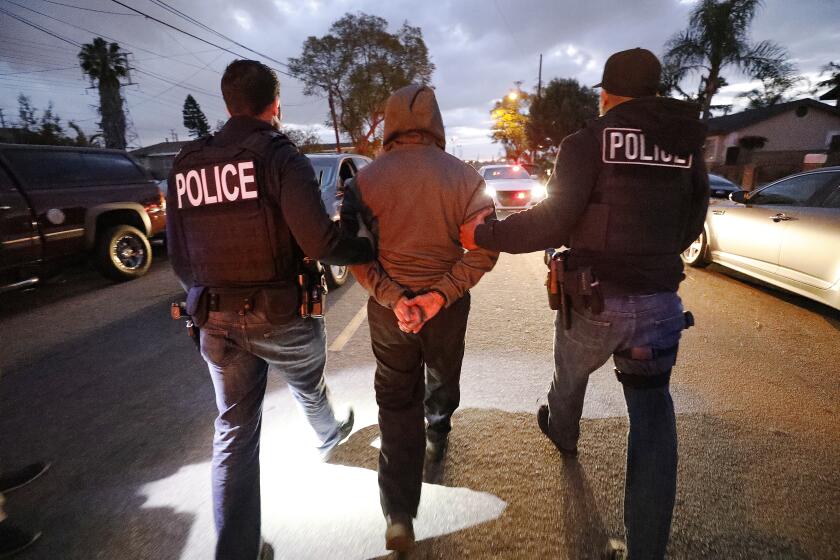Burbank Airport Bomb Scare Was All Bust, No Boom
In the end, the crisis fizzled. It turned out that an allegedly drunken man detained as a suspected would-be bomber at Burbank Airport was packing nothing more lethal than a laptop. He was released without being charged, the whole thing a mistake.
But his tripping of an explosive-detection alarm plunged the airport into chaos for more than six hours April 20, as authorities scrambled to determine if he posed a threat. Their slow and somewhat confused response has since raised questions of whether the airport is prepared for such an emergency, the first of its type there in anyone’s memory.
Airport and Burbank police officials insist they handled the situation as best they could. They say they notified law enforcement agencies within half an hour, including the FBI and a Los Angeles County Sheriff’s Department bomb squad, and moved quickly to close most of one of the airport’s two terminals.
But the FBI says it wasn’t called until three hours later, at 7:30 p.m. And the airport, because of a mutual aid contract with the Sheriff’s Department, summoned the bomb team from Whittier, 31 miles away, instead of one from the Los Angeles Police Department, just nine miles away. Fighting rush-hour traffic on a rainy Friday, the sheriff’s squad did not arrive in Burbank for an hour and 20 minutes.
In the meantime, as flight delays piled up, airport authorities evacuated and closed Terminal A, home to Southwest and America West gates. Throughout the evening, however, they allowed planes to taxi up to some of the terminal gates. That cast doubt on how seriously officials took the bomb threat.
All the while, an angry mass of passengers desperate for answers steadily grew in front of the ticket counters. Outside, the police coned off Hollywood Way and traffic backed up for blocks. The first official word of trouble--an announcement of a “security risk”--was not relayed on the airport’s public address system until 8 p.m., more than four hours after the emergency began. An all-clear was not sounded until 10:15 p.m.
Passenger advocates call that inexcusable, especially considering the sophisticated technology available for airport security systems.
“Airports that have a lot of bomb threats, they take care of these things in minutes,” said Paul Hudson, executive director of the Aviation Consumer Action Project and a member of a Federal Aviation Administration security advisory committee.
Airport and law enforcement officials, however, say they were dealing not only with a potential bomb, but a man who was too intoxicated to answer questions. In addition, they add, the man’s carry-on bag contained three vials of liquid that could not be immediately identified. Security officials tested the bag three times for explosive residue and all came up positive, even though there was no sign of a bomb.
The positive reading suggested the presence of PETN, or pentaerythritol tetranitrate, a chemical used in explosives such as Semtex, a favorite of terrorists, said sheriff’s officials and Robert Beaudet, a USC chemistry professor. But the FAA, airline officials and private security experts say the explosives trace detectors can be triggered by medications and some fertilizers. Fewer than 1% of positive readings are false, the FAA said.
A FAA spokesman said the liquid in the carry-on bag was harmless, and that the agency is conducting an inquiry into what set off the detector. Initial concerns about the man’s laptop computer proved false, authorities said.
Ravi Desai, a 31-year-old Menlo Park computer consultant, confirmed Saturday that he was the person detained at the airport. He said he had had two drinks but was not drunk when he arrived at the airport.
He said his communication may have been hampered by a severe stutter. “[It] comes and goes, as all stutters do,” he said. “At that point it may have been more severe.”
Desai said the so-called vials were two bottles of spring water and a half-empty bottle of Smirnoff vodka--all of which were clearly marked and in their original packaging.
Desai said he had come to Los Angeles for a job interview. Though he characterized the ensuing ordeal as “horribly unpleasant,” he said FBI agents and other authorities acted professionally during his interrogation.
When the emergency unfolded, airport officials said, protocol required a call to the Burbank Police Department, though they also contacted the Sheriff’s Department. In this case, the FBI also was notified. The sheriff’s bomb squad opted not to take a helicopter to Burbank.
“If we had a pipe bomb on the freeway, we would fly in because we don’t need that much equipment,” said Det. Tim Wainscott of the sheriff’s arson and explosives unit. He said the airport call required a 500-pound robot, three X-ray machines, hazardous materials equipment, body armor and other gear that were already loaded on a truck. Shifting that gear to a helicopter might have delayed a response, he said.
Burbank Police Lt. Wade Taylor said it typically takes the sheriff’s bomb squad about an hour to reach any scene in Burbank. Other officials said the sheriff’s team could have called the LAPD bomb squad for help, but chose not to.
Larger airports such as LAX have FBI agents on site to deal with bomb scares, but the Burbank airport does not, officials said. FAA spokesman Jerry Snyder said the Burbank incident marked the first time a U.S. airport was hampered by such a long delay after one of its explosives detection devices was tripped. The agency bought the detectors in the late 1990s for 500 airports.
Wainscott said the long, partial closure of the airport was “absolutely justified” because of the time it took to thoroughly examine the bag and liquids.
Adding to the confusion and frustration of passengers were announcements in other cities that Burbank Airport was completely closed. Altogether, more than 3,000 passengers were affected by flight delays and cancellations.
Officials contend each emergency is different and some confusion and delays are inevitable.
“If it turns out that nothing happened, people would react angrily and minimize what we were doing because they’ve been inconvenienced and delayed,” Taylor said. “But if we make a mistake and it’s a device that hurts somebody, the same people would say they were placed in unnecessary danger.”
*
Times staff writer Richard Fausset contributed to this story.
More to Read
Start your day right
Sign up for Essential California for news, features and recommendations from the L.A. Times and beyond in your inbox six days a week.
You may occasionally receive promotional content from the Los Angeles Times.






